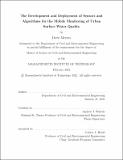The Development and Deployment of Sensors and Algorithms for the Mobile Monitoring of Urban Surface Water Quality
Author(s)
Meyers, Drew
DownloadThesis PDF (19.39Mb)
Advisor
Whittle, Andrew J.
Terms of use
Metadata
Show full item recordAbstract
Although water quality extensively improved over the last decade, recreational uses of the canal network in Amsterdam are limited by variations in water quality associated with stormwater runoff and episodic harmful algal blooms. The current systems for monitoring water quality are based principally on a stationary network of sampling points and offline testing. There have also been a number of programs to online measurements from a mobile platform/vessel that have focused principally on non-specific indicators of water quality (pH, conductivity, dissolved oxygen etc.). This thesis describes the development and deployment of sensors and algorithms for the monitoring of algal concentrations and identifying algal classes based on their fluorescing pigments in urban surface water of Amsterdam.
In the first chapter, we demonstrate that by using only a single patrol vessel, we are able to observe spatiotemporal heterogeneity of algal and chemical water quality within the Amsterdam canal network. The data provide encouraging evidence that opportunistic measurements from a small number of mobile platforms can enable high-resolution mapping and can be used to improve modeling and control of water quality across the city.
In the second and third chapters we present the development of standardized and reproducible data pipelines, open-source software tools, and algorithms for analyzing fluorescence excitation emission matrices. The data pipeline and algorithms are employed to investigate the identification and quantification of algae in complex mixtures.
The final chapter describes the development and characterization of a field-deployable high-resolution spectrofluorometer for the real-time mobile monitoring of algae. The chapter provides encouraging evidence that such an instrument can begin moving from the lab to the field in order to investigate real-time phenomenon in situ. This move will provide limnologists and oceanographers with a new tool to investigate new questions of aquatic ecology and assist water utilities in managing water quality.
Date issued
2022-02Department
Massachusetts Institute of Technology. Department of Civil and Environmental EngineeringPublisher
Massachusetts Institute of Technology